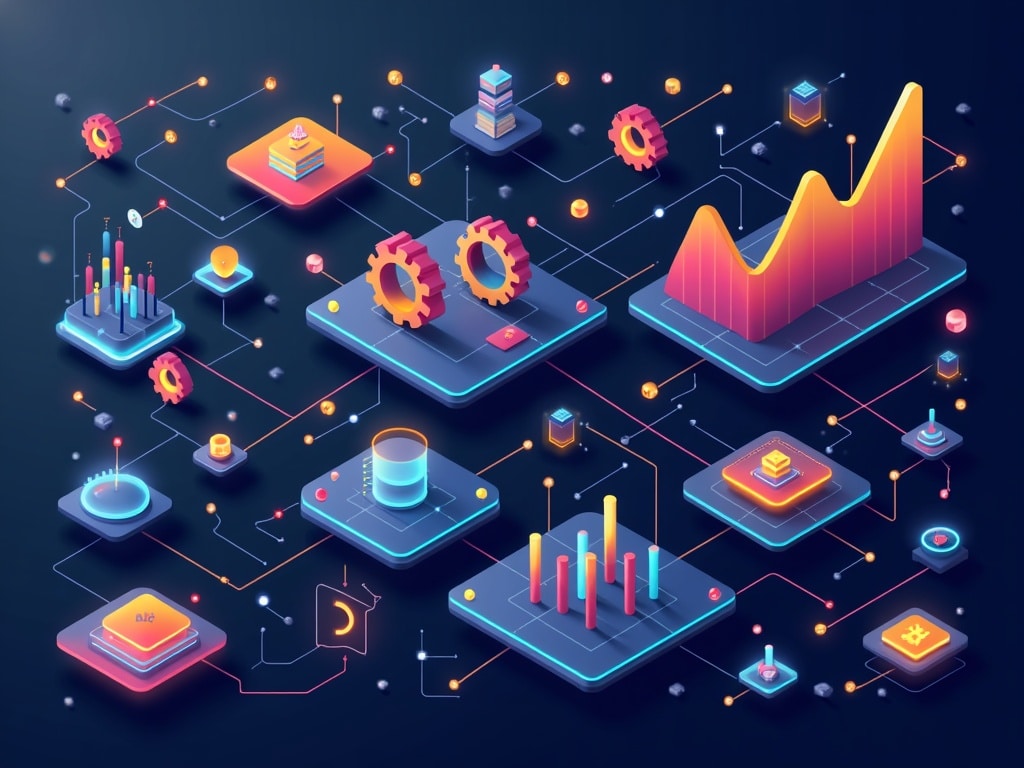Mastering Data Analysis Workflows with Python: A Practical Example
Imagine you’re a detective, but instead of clues at a crime scene, you have datasets teeming with potential insights. Your magnifying glass? Python. Your mission? To transform raw, chaotic data into actionable intelligence. Data analysis workflows can seem daunting, but with Python as your ally, you can streamline the process, uncover hidden patterns, and make data-driven decisions. Let’s embark on a journey through a practical example, illuminating each step along the way.
Understanding the Data Analysis Workflow
At its core, a data analysis workflow is a structured sequence of steps designed to extract meaningful information from data. Think of these steps as gears in a well-oiled machine, each contributing to the final output: actionable insights. These steps typically include:
- Data Collection: Gathering data from various sources.
- Data Cleaning: Handling missing values, correcting errors, and ensuring data quality.
- Data Exploration/Analysis: Using statistical methods and visualizations to understand data patterns.
- Modeling: Building predictive models based on the insights gained.
- Interpretation and Communication: Drawing conclusions and presenting findings in a clear, concise manner.
Why Python?
Python has become the lingua franca of data analysis for several compelling reasons:
- Rich Ecosystem of Libraries: NumPy, Pandas, Matplotlib, Seaborn, Scikit-learn, and more provide powerful tools for every stage of the analysis.
- Ease of Use: Python’s syntax is clear and readable, making it easier to learn and use than many other programming languages.
- Large and Active Community: A vast community provides ample support, resources, and pre-built solutions.
- Versatility: Python can be used for everything from web scraping data to building complex machine learning models.
A Practical Example: Analyzing Customer Sales Data
Let’s dive into a practical example to illustrate how a data analysis workflow with Python works. Suppose you’re a data analyst at an e-commerce company, and your task is to analyze customer sales data to identify trends and improve sales strategies.
1. Data Collection
The first step is to gather the data. This might come from various sources such as databases, CSV files, or APIs. For this example, let’s assume the data is in a CSV file named `sales_data.csv`. This `sales_data.csv` file contains records of each transaction, with fields like customer ID, product ID, purchase date, purchase amount, and customer location.
2. Data Cleaning with Pandas
Pandas is the workhorse of data cleaning in Python. It provides powerful data structures like DataFrames that make it easy to manipulate and analyze tabular data.
python
import pandas as pd
# Load the data
sales_data = pd.read_csv(‘sales_data.csv’)
# Display the first few rows
print(sales_data.head())
# Check for missing values
print(sales_data.isnull().sum())
# Handle missing values (e.g., fill with the mean or median)
sales_data[‘PurchaseAmount’].fillna(sales_data[‘PurchaseAmount’].mean(), inplace=True)
# Remove duplicate rows
sales_data.drop_duplicates(inplace=True)
# Convert ‘PurchaseDate’ to datetime objects
sales_data[‘PurchaseDate’] = pd.to_datetime(sales_data[‘PurchaseDate’])
# Print cleaned dataframe info
print(sales_data.info())
This code snippet demonstrates how to load data, check for and handle missing values, remove duplicates, and convert data types using Pandas. The `info()` method is invaluable for understanding the structure and data types of your DataFrame.
3. Data Exploration and Analysis with NumPy, Pandas, and Matplotlib
Now that the data is clean, it’s time to explore it. We’ll use NumPy for numerical operations, Pandas for data manipulation, and Matplotlib for visualization.
python
import numpy as np
import matplotlib.pyplot as plt
import seaborn as sns
# Basic statistics
print(sales_data[‘PurchaseAmount’].describe())
# Group sales by date
daily_sales = sales_data.groupby(‘PurchaseDate’)[‘PurchaseAmount’].sum()
# Plot daily sales
plt.figure(figsize=(12, 6))
plt.plot(daily_sales.index, daily_sales.values)
plt.xlabel(‘Date’)
plt.ylabel(‘Total Sales’)
plt.title(‘Daily Sales Trend’)
plt.grid(True)
plt.show()
# Analyze sales by customer location
location_sales = sales_data.groupby(‘CustomerLocation’)[‘PurchaseAmount’].sum().sort_values(ascending=False)
# Print top 10 locations by sales
print(location_sales.head(10))
# Plot sales by customer location using seaborn
plt.figure(figsize=(12, 6))
sns.barplot(x=location_sales.head(10).index, y=location_sales.head(10).values)
plt.xlabel(‘Customer Location’)
plt.ylabel(‘Total Sales’)
plt.title(‘Top 10 Customer Locations by Sales’)
plt.xticks(rotation=45, ha=’right’)
plt.tight_layout()
plt.show()
This code calculates basic statistics, groups sales by date and location, and generates plots to visualize the results. Matplotlib and Seaborn allow you to create a wide range of visualizations, including line plots, bar charts, scatter plots, and histograms.
4. Feature Engineering
Feature engineering involves creating new features from existing ones to improve the performance of machine learning models or gain additional insights. Let’s extract the month and year from the ‘PurchaseDate’ column:
python
# Extract month and year from PurchaseDate
sales_data[‘PurchaseMonth’] = sales_data[‘PurchaseDate’].dt.month
sales_data[‘PurchaseYear’] = sales_data[‘PurchaseDate’].dt.year
# Group sales by month and year
monthly_sales = sales_data.groupby([‘PurchaseYear’, ‘PurchaseMonth’])[‘PurchaseAmount’].sum()
# Print monthly sales
print(monthly_sales)
# Further exploration: average purchase amount per customer
avg_purchase_per_customer = sales_data.groupby(‘CustomerID’)[‘PurchaseAmount’].mean()
print(avg_purchase_per_customer.describe())
By extracting the month and year, we can analyze sales trends on a monthly or yearly basis. Analyzing metrics like average purchase amount per customer can provide insights into customer behavior.

5. Modeling with Scikit-learn
Now, let’s build a simple model to predict future sales. This is where Scikit-learn comes in. Keep in mind that for accurate forecasting, you might need more sophisticated time series analysis techniques. This example is for demonstrative purposes.
python
from sklearn.model_selection import train_test_split
from sklearn.linear_model import LinearRegression
from sklearn.metrics import mean_squared_error
# Prepare the data for modeling
# Using PurchaseMonth and PurchaseYear as features, and PurchaseAmount as the target variable
X = sales_data[[‘PurchaseMonth’, ‘PurchaseYear’]]
y = sales_data[‘PurchaseAmount’]
# Split the data into training and testing sets
X_train, X_test, y_train, y_test = train_test_split(X, y, test_size=0.2, random_state=42)
# Train the linear regression model
model = LinearRegression()
model.fit(X_train, y_train)
# Make predictions on the test set
y_pred = model.predict(X_test)
# Evaluate the model
mse = mean_squared_error(y_test, y_pred)
print(f’Mean Squared Error: {mse}’)
# Visualize the predictions
plt.figure(figsize=(12, 6))
plt.scatter(y_test, y_pred)
plt.xlabel(‘Actual Sales’)
plt.ylabel(‘Predicted Sales’)
plt.title(‘Actual vs. Predicted Sales’)
plt.grid(True)
plt.show()
This code demonstrates how to train a linear regression model using Scikit-learn. The data is split into training and testing sets, the model is trained on the training data, and then used to make predictions on the test data. The mean squared error is used to evaluate the model’s performance.
6. Interpretation and Communication
The final step is to interpret the results and communicate your findings to stakeholders. This might involve creating a report, giving a presentation, or building a dashboard.
Based on the analysis, some potential findings might include:
- Sales are trending upwards over time.
- Certain customer locations generate significantly more sales than others.
- Sales peak during certain months of the year.
- The linear regression model can predict sales with a certain degree of accuracy (as indicated by the MSE).
These insights can then be used to inform business decisions, such as:
- Targeting marketing campaigns to high-performing customer locations.
- Adjusting inventory levels to meet seasonal demand.
- Improving customer retention strategies based on purchase behavior.
Advanced Techniques and Tools
While this example provides a basic overview of a data analysis workflow, there are many advanced techniques and tools that can be used to enhance the process.
- Time Series Analysis: For more accurate sales forecasting, techniques like ARIMA, Exponential Smoothing, and Prophet can be used.
- Machine Learning Algorithms: Explore more sophisticated algorithms like Random Forests, Gradient Boosting, and Neural Networks for prediction tasks.
- Data Visualization Tools: Tools like Tableau, Power BI, and Plotly provide interactive and customizable data visualization options.
- Cloud Computing Platforms: Platforms like AWS, Azure, and Google Cloud offer scalable computing resources and data storage solutions.
- Big Data Technologies: For very large datasets, technologies like Spark and Hadoop can be used to process and analyze data in a distributed manner.
Best Practices for Data Analysis Workflows
To ensure the success of your data analysis projects, it’s essential to follow some best practices:
- Clearly Define Objectives: Start with a clear understanding of the business questions you’re trying to answer.
- Document Your Workflow: Keep a detailed record of each step in the analysis process, including code, data sources, and assumptions.
- Use Version Control: Use Git to track changes to your code and data.
- Test Your Code: Write unit tests to ensure that your code is working correctly.
- Collaborate Effectively: Share your code and data with colleagues and get feedback.
- Automate Repetitive Tasks: Use scripting and automation tools to streamline repetitive tasks.
- Ensure Data Security and Privacy: Protect sensitive data by following best practices for data security and privacy.
The Importance of Reproducibility
Reproducibility is a cornerstone of good data analysis. Ensure that anyone can rerun your analysis and obtain the same results. This involves:
- Using a virtual environment to manage dependencies.
- Storing data and code in a structured manner.
- Providing clear instructions for running the analysis.
By adhering to these practices, you can increase the reliability and credibility of your data analysis. You might consider utilizing specific libraries for data version control to further enhance the reproducibility of your workflows.
Conclusion
Mastering data analysis workflows with Python is a journey, not a destination. By understanding the fundamental steps, leveraging the power of Python’s libraries, and following best practices, you can transform raw data into actionable insights. The example of analyzing customer sales data illustrates how these principles can be applied in a real-world scenario. As you continue to explore and refine your skills, you’ll unlock the full potential of data analysis and drive better business outcomes. So, embrace the challenge, experiment with different techniques, and never stop learning! The world of data awaits.
